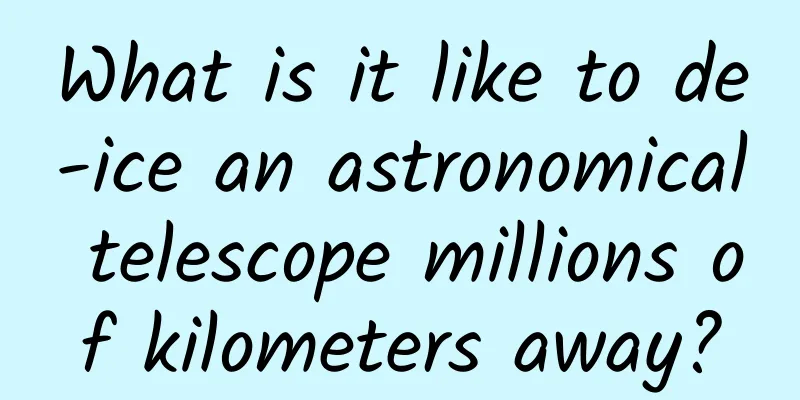What is it like to de-ice an astronomical telescope millions of kilometers away?

|
"The de-icing program should restore and preserve Euclid's ability to collect pristine galactic starlight, but this is also the first time we have conducted this procedure." De-icing? For space telescopes? Image of the space agency's "dark universe survey" spacecraft Euclid, ready to go into full science mode. (Image credit: ESA) Just as drivers scrape ice off their windshields in the winter, the space agency's (ESA) Euclid Observatory is trying to de-ice astronomical telescopes millions of kilometres away. The Euclid telescope's mirrors have been coated with a layer of ice as thick as the width of a strand of DNA, a spokesperson said in a statement on Tuesday, March 19. Although the ice is thin, its presence has caused a "small but gradual decrease" in the telescope's ability to capture large amounts of starlight. Scientists are beginning to remove the ice by heating low-risk areas of the spacecraft's optics while the telescope conducts science observations. The spokesperson said that water melting in low-risk areas of various parts of the telescope will not damage other parts. "The de-icing process should preserve Euclid's ability to collect starlight from the original galaxy, but this is the first time we've done this process, and although we can roughly guess where the ice is, it still needs to be confirmed specifically," said Mitsuko Nakajima, a Euclid scientist at the University of Berlin in Germany. This problem is not uncommon for space telescopes. Scientists know that it is almost impossible to prevent any water from entering the spacecraft during assembly, so "it was expected that this water would accumulate and contaminate Euclid's view," ESA said in a statement on Tuesday. Shortly after Euclid was launched last July, scientists used an onboard heater to heat the telescope in an attempt to evaporate most of the water molecules that were present inside the spacecraft before launch. But it seems that a significant portion still entered the telescope's multi-insulation layer and dispersed when it reached the vacuum environment. In the cold vacuum environment, these water molecules tend to condense on the surface of the space telescope's mirror. The mission team first discovered the problem when they saw a gradual decrease in the starlight they measured using one of Euclid's two science instruments, the Visible Light Instrument (VIS). To measure 1.5 billion galaxies and their star populations, VIS collects visible light from these stars in a similar way to a smartphone camera, but with 100 times more pixels. The resolution of VIS is equivalent to that of a 4k screen. Get the Space Network Newsletter Breaking space news! The latest on rocket launches, observation activities and more! "Some stars in the universe vary in brightness, but the vast majority remain constant over millions of years," Michail Hirmer, a Euclid scientist leading the de-ice mission, said in the statement. "So when our instruments captured a picture of a starlight that was fading slightly, we realized it wasn't the stars that were causing it, it was us." The simplest solution would be to heat the spacecraft, mission scientists say, but that would also heat up the telescope's mechanics, causing its components to expand and not necessarily return to their original state even a week later. That would limit Euclid's field of view and, by extension, affect the quality of data it collects. Telescopes are affected by even the slightest temperature changes. So Hillmer and her colleagues plan to heat low-risk Euclid optical components first. They'll start with two mirrors that can be heated independently of each other, and then monitor how that affects the amount of light collected by VIS. The icing problem is the second one the telescope has run into. Last September, a sensor the telescope uses for navigation mistakenly labeled cosmic rays as stars, meaning that the star patterns the telescope relies on to point to a specific area of the sky could not resolve the stars. A month later, that problem was fixed. For this latest problem, scientists expect Euclid to continue releasing small amounts of water over its six-year lifespan in orbit, so if their de-icing campaign is successful this time, the same procedure could keep Euclid's systems ice-free for subsequent missions. BY:Sharmila Kuthunur FY: All sorts of things If there is any infringement of related content, please contact the author to delete it after the work is published. Please obtain authorization for reprinting, and pay attention to maintaining integrity and indicating the source |
<<: Learn from dolphins! Learn the secrets of sound waves and become more comfortable underwater~
Recommend
Haidilao's ads will become invisible丨6 ways to make ads invisible
I have previously written an article about how “ ...
Tik Tok marketing promotion, how can one video gain 480,000 followers in 2 days?
Faced with the trend of Douyin, the actual situat...
Is coughing up phlegm a way for the body to detoxify? Different colors of phlegm indicate different diseases!
It’s autumn now, the weather is cool, the moon is...
Snowfall in many places! When traveling on snowy days, pay special attention to these points!
Since the beginning of winter, many places have a...
A review of 15 best-selling marketing campaigns in the first half of 2018
Looking back at the first half of 2018, marketing...
When participating in a project, what do you need to learn and record?
Eiichiro Misaki, the author of "Don't Tel...
Where is the most beautiful ginkgo tree in China?
The ginkgo leaves are turning yellow, and autumn ...
Detailed tutorial on Tik Tok operation, algorithm interpretation, platform rules...
Tik Tok has all the motivations to be addictive. ...
Why do I always wake up when I reach my stop after falling asleep on the subway?
Audit expert: Sun Tao National Psychological Coun...
Experts say that the fabrics of Bosideng's 10,000-yuan down jackets are very cheap? Where is Bosideng heading to the high-end market?
In recent years, with the continuous improvement ...
Damage to the liver, change genes? Do you still dare to "eat rainbow"?
Snacks are really a magical thing. From children ...
How can ordinary people use quantum computers?
How can ordinary people get in touch with real qu...
How about Baidu AiPurchasing?
1. Baidu AiPurchasing Customer Service In order t...
A 3,000-year-old scent reveals the secrets of an ancient Egyptian tomb
More than 3,400 years ago, two ancient Egyptians ...
Detailed explanation of adapter mode and application scenarios of Android design pattern
[[417879]] Preface Design patterns are sometimes ...









